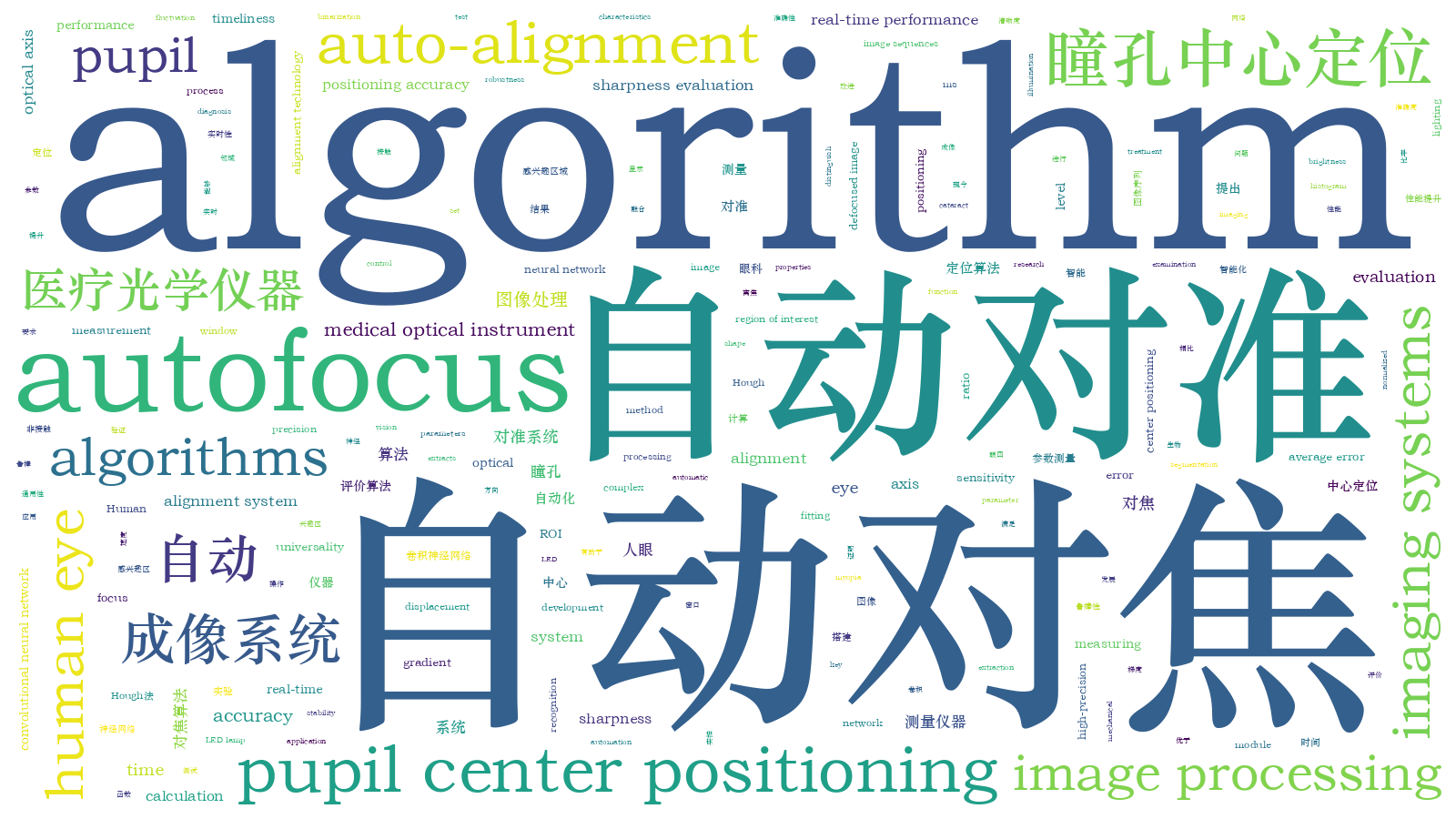人眼自动对焦及瞳孔中心自动对准系统  下载: 663次
下载: 663次
The measurement of ocular optical biological parameters is a key part of the ophthalmic examination, and it is very important for the diagnosis and treatment of ophthalmic diseases such as myopia and cataract. For the existing ophthalmic measuring instruments, operators mainly use the joystick to manually control the movement of the instruments, so as to realize focus and alignment of the subject's eyes. The evaluation criteria of this process are subjective, and the process is slow and involves complicated operations. In recent years, many scholars have carried out research on human eye autofocus and pupil center positioning methods and have proposed some solutions. However, there are still problems such as poor real-time performance of the algorithm, relatively insufficient positioning accuracy, and poor generality. Therefore, the application of autofocus and auto-alignment technology reflects a development direction and practical demand of automatic ophthalmic measuring instruments.
A human eye autofocus and pupil center auto-alignment system for ophthalmic measuring instruments is built. The system is mainly composed of a fixed vision module, an LED lamp bead plate, an imaging module, a three-axis electric displacement stage, and a head holder. By analyzing the characteristics of human eye images, an autofocus algorithm based on a four-neighborhood-multi-directional and two-level gradient function (FMTG algorithm) was proposed. The algorithm replaces the center pixel with the mean value of the center pixel and the four-neighborhood pixel for calculation, calculates the two-level gradient in the horizontal direction, vertical direction, and direction with an oblique of 45° at the same time, and takes the product of the two-level gradient operators as the sharpness evaluation value. A pupil center positioning algorithm (LPC algorithm) based on the intelligent region of interest (ROI) window of a convolutional neural network was proposed. The algorithm extracts the image coordinates of the pupil center and optical axis for alignment through steps including the extraction of the pupil region of interest, histogram-based binarization segmentation, and high-precision ellipse recognition and fitting. The performance of the proposed FMTG algorithm was verified by the system built in this paper and by actually shooting four groups of human eye-defocused image sequences. Six commonly used evaluation functions were selected for comparison, and their normalized sharpness evaluation curves were drawn. Three quantitative indicators, namely, single-frame processing time, sharpness ratio, and sensitivity, as well as two important properties such as unimodality and accuracy, were selected to comprehensively evaluate the performance of the functions. The performance of the proposed LPC algorithm and other algorithms for comparison was evaluated in terms of the average computation time, accuracy, and average error through the test set of real-shot human eye images. In addition, the proposed LPC algorithm was tested under complex conditions with different illumination and partial pupil occlusion to evaluate the universality of the algorithm.
The FMTG algorithm proposed in this paper has a sharper evaluation curve shape and a stronger ability to distinguish on-focus images from out-of-focus images (Fig. 10). Its average calculation time is about 13 ms, with a sharpness ratio of 93.531, and the sensitivity is 0.329, which are all better than that of other six traditional evaluation algorithms and reflect good unimodality and accuracy (Table 1). The error curve of the LPC algorithm proposed in this paper has small fluctuation and good stability, and the algorithm can adapt to certain environmental changes (Fig. 12). The average calculation time of the LPC algorithm is 10.2 ms, with an accuracy of 97.14%, and the average error is 1.4 pixel, which indicate that the LPC algorithm has been greatly improved compared with the Hough method and the improved Hough method (Table 2). In addition, the proposed LPC algorithm can adapt to lighting environments with different brightness and darkness and situations where the pupil is partially occluded, and thus it shows good universality (Fig. 13).
This paper proposed a human eye autofocus and pupil center auto-alignment system applied to ophthalmic measuring instruments. The system realized the autofocus of the human eye region through an autofocus algorithm based on the FMTG algorithm and then delimited the ROI window through a convolutional neural network. In addition, it adopted an ellipse recognition and fitting algorithm to accurately locate the pupil center and optical axis and finally used the mechanical movement of the three-axis high-precision displacement stage to achieve the alignment of the human eye pupil center and optical axis. The experimental results show that the average calculation time of the FMTG algorithm proposed in this paper is about 13 ms, and the evaluation indicators such as sharpness ratio and sensitivity are higher than those of the traditional algorithms, and the FMTG algorithm has good unimodality and accuracy. The proposed LPC algorithm has an average calculation time of 10.2 ms and an accuracy of 97.14%. It can adapt to complex environments with different lighting and partially occluded pupils and has great accuracy and universality. The experimental results show that the system built in this paper can meet the requirements of accuracy, timeliness, and robustness of ocular biological parameter measurement, improve the automation level of the instruments, and contribute to the intelligent development of ophthalmic measurement instruments.
汪路涵, 巩岩, 张艳微, 郎松, 郑汉青. 人眼自动对焦及瞳孔中心自动对准系统[J]. 光学学报, 2023, 43(5): 0511002. Luhan Wang, Yan Gong, Yanwei Zhang, Song Lang, Hanqing Zheng. Human Eye Autofocus and Pupil Center Auto-Alignment System[J]. Acta Optica Sinica, 2023, 43(5): 0511002.







